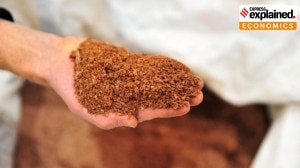Area-specific varieties for a better yield
The Central Rice Research Institute in Orissa has developed rice varieties suitable for cultivation in the states different agro-climatic regions....
Rice is Orissas staple food,and with 65 per cent of the states population deriving its livelihood from agriculture,mostly paddy,a lot depends on the success of the crop. Too much or too little rain as well as extra saline water can spell catastrophe for the crop.
But help seems to be at hand. The Indian Council of Agricultural Researchs Central Rice Research Institute,near Cuttack city,has come up with at least 11 new high-yielding varieties of rice,five of which are exclusively suitable for cultivation in different agro-climatic zones of Orissa. The institute,spread over 62 acres,in Bidyadharpur village on the outskirts of Cuttack,has developed varieties that can be grown with very little water as well in saline conditions,prevalent in coastal Orissa.
While varieties CR Dhan-701,CR Dhan-601,CR Boro Dhan-2,CR Dhan-401 and CR Dhan-501 were released by the Central Variety of Release Committee for cultivation in Bihar,Gujarat,Assam,Tamil Nadu,West Bengal and Andhra Pradesh,the Orissa sub-committee released CR Dhan-801,CR Dhan-401,CR Dhan-402,CR Dhan-403 and CR Dhan-901 for cultivation in the state.
All these varieties are significant improvements on the current hybrids in use. Apart from being high-yielding,they will take less time to mature and thus reduce the cost of farming. Most of all,they are area-specific, said Director of CRRI Tapan Adhya. We wanted to develop a variety for high saline conditions as saline water ingress in coastal paddyfields is a common phenomenon in districts like Jagatsinghpur,Kendrapara,Puri as well as Balasore.
CR Dhan-801,a photosensitive,superfine rice developed for hilly areas and plateaus was a result of double haploid breeding from the hybrid rice variety KRH-2. With this technique,one doesnt have to wait 10 years to breed a new varietyin conventional breeding,two varieties of rice are crossed and plants derived from the hybrid are followed for six-seven generations till the right plant with all the desired characteristics is identified. Double haploid breeding takes about six years.
The CR Dhan-801 variety yields 5 tonne/hectare in kharif (rainy season) and 5-6 tonne/hectare in Rabi(winter season). It has high head rice recovery (HRR) of 66 per centHRR is the percentage of whole rice one gets after milling paddyand can be harvested in less than four months after sowing seeds.
For coastal Orissa battling saline water ingress,there is CR Dhan-402,with medium slender grains,yielding 3.5 tonnes/hectare in 150 days and superior to existing saline-resistant varieties like Khandagiri,Lunishree and SR 26B. Another variety,the CR Dhan-403,will yield 3.5 to 4.3 tonnes/hectare in 123 days.
The CR Dhan-401 variety developed as a cross of Savitri and IR44 varieties is suitable for the shallow low-lands of Orissa,West Bengal,Tamil Nadu and Andhra Pradesh. The semi-dwarf CR Dhan-401 ripens in 145-150 days,possesses medium slender grains,yielding 5.4 tonnes/hectarefar more than its parentsand is resistant to white-backed planthopper,a pernicious paddy crop pest. With these varieties,the farmers dont have to buy the seeds every year and can use the seeds from the previous years harvest, Adhya said.
CRRI is now working on a variety that can be grown without standing water in the fields. If we are successful,we can reduce our dependency on rainfall, said Adhya.





- 01
- 02
- 03
- 04
- 05


























